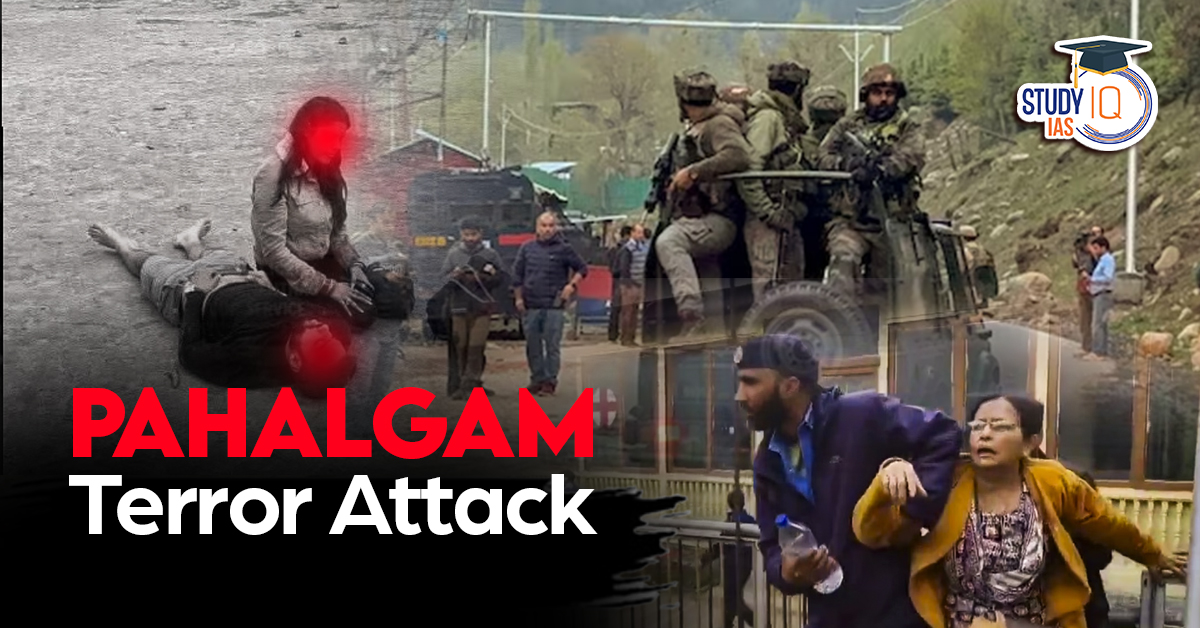Table of Contents
Pahalgam Terror Attack: In a tragic and shocking act of terrorism, 26 people were killed in a brutal terror attack on April 22, 2025, in Pahalgam, a picturesque tourist destination in Anantnag district, Jammu and Kashmir. The attack, which targeted civilians including tourists, security personnel, and foreign nationals, is being seen as one of the deadliest attacks on civilians in the region in recent years. India launched Operation Sindoor as a revenge operation in response to the Pahalgam terror attack on 7th May 2025.
Pahalgam Terror Attack
Pahalgam Terror Attack began at around 2:30 PM when heavily armed terrorists descended on the Baisaran Valley, often referred to as ‘Mini Switzerland‘. Eyewitness accounts suggest that multiple terrorists opened indiscriminate fire, causing chaos and panic. Tourists ran for cover, but with open meadows and few places to hide, many were caught in the line of fire.
India Suspends Indus Water Treaty with Pakistan
| India Responds to the Pahalgam Terror Attack with Strict Measures Against Pakistan |
|
What Happened in Pahalgam?
In a shocking and brazen act of terrorism, 26 people were killed and several others injured on April 22, 2025, when heavily armed terrorists opened indiscriminate fire on a group of tourists in Baisaran Valley, a scenic spot in Pahalgam, Jammu and Kashmir. The valley, popularly called Mini Switzerland, turned into a battlefield as militants struck in broad daylight.
The Pahalgam terror attack is being described as one of the deadliest civilian-targeted terror attacks in Jammu and Kashmir in the last decade. The attack comes amid a growing wave of foreign and domestic tourism in the region.
Operation Tikka: India’s Counter-Terror Action Begins after Pahalgam Terror Attack
Following the massacre, Indian security forces swiftly launched Operation Tikka, a high-level counter-terror operation involving:
-
Indian Army
-
CRPF (Central Reserve Police Force)
-
J&K Police
-
National Investigation Agency (NIA)
The goal is to neutralise the attackers, trace their infiltration route, and dismantle sleeper cells that supported the logistics of this operation. Choppers, drones, and satellite imaging are also being used due to the rugged terrain of South Kashmir.
Who Were the Victims in Pahalgam Terror Attack?
Among the 26 victims of the Pahalgam Terror Attack were:
-
A Navy officer who got married just a week ago
-
An IB officer, killed in front of his wife
-
Two foreign nationals — one from the UAE and one from Nepal
-
Two locals from Anantnag
The indiscriminate nature of the attack indicates a deliberate targeting of civilians and tourists, meant to disrupt peace and destabilise the valley’s growing tourism economy.
Who Is Behind the Pahalgam Terror Attack?
While no official statement has confirmed the group, initial intelligence points to The Resistance Front (TRF), a shadow organization of the banned Pakistani terror outfit Lashkar-e-Taiba (LeT).
Sources claim the attackers infiltrated via Kokernag in South Kashmir after crossing over from Kishtwar — a known route used by trained militants in the past.
Government’s Response: Strong and Swift
Prime Minister Narendra Modi, who was on an official visit to Saudi Arabia at the time of the attack, cut short his trip and returned to India immediately. In a post on X (formerly Twitter), he strongly condemned the attack:
“Those behind this heinous act will be brought to justice. Their evil agenda will never succeed. Our resolve to fight terrorism is unshakable.”
He convened an urgent meeting of the Cabinet Committee on Security (CCS). Key ministers, including Union Home Minister Amit Shah, Defence Minister Rajnath Singh, and NSA Ajit Doval, were present to strategise a national-level response.
Finance Minister Nirmala Sitharaman also cut short her official visit to the USA and Peru to return to India.
National and International Reactions
The attack has drawn sharp condemnation from all corners:
-
Opposition leaders, including Rahul Gandhi, extended condolences and called for accountability.
-
Omar Abdullah, former J&K Chief Minister, termed the attack “much larger than anything we’ve seen directed at civilians in recent years.”
Internationally, several world leaders have expressed solidarity:
-
US President Donald Trump
-
Russian President Vladimir Putin
-
Italian PM Giorgia Meloni
-
UN Secretary-General António Guterres
-
European Union Chief Ursula von der Leyen
All have called the attack “barbaric” and offered support to India in its fight against terrorism.
Impact on Tourism and Travel in Jammu and Kashmir
The attack has severely impacted tourism in the region:
-
24/7 emergency helplines have been established in Srinagar and Anantnag.
-
Air India and IndiGo are operating additional flights to and from Srinagar and have waived cancellation/rescheduling charges.
-
Security has been ramped up at all major tourist spots and transit hubs across the country, especially in Delhi, Mumbai, and Bangalore.
Emergency Helplines Activated
For those seeking assistance regarding the Pahalgam terror attack:
-
Srinagar Emergency Control Room: 0194-2457543, 0194-2483651
-
ADC Srinagar – Adil Fareed: +91-7006058623
-
24×7 Tourist Help Desk – Anantnag PCR: 9596777669 | 01932-225870
-
Tourism Department: 8899931010 | 9906663868
Terrorism: Introduction
- Terrorism has evolved across centuries—from state-sponsored violence to ideological extremism—reflecting the changing nature of power, politics, and conflict.
- Its earliest traces lie in the Reign of Terror during the French Revolution(1793–94), where the state used fear as a political tool.
- Ancient groups like the Sicarii (1st century CE) and Assassins (11th century) marked the beginning of targeted killings for religious or political ends.
- In the 19th century, terrorism became associated with anarchist and revolutionary movements, notably the Narodnaya Volya in Russia, which assassinated Tsar Alexander II in 1881.
- The 20th century witnessed a surge in nationalist and separatist terrorism, as seen in the activities of the IRA in Ireland, FLN in Algeria, and ETA in Spain.
- The 21st century has seen a shift to transnational religious terrorism, driven by networks like al-Qaeda and ISIS, employing modern communication tools and decentralised strategies to spread fear globally.
- Thus, terrorism has transformed from localised political violence to a global asymmetric threat, impacting national and international security alike.
Is Terrorism a Crime or a War?
- Terrorism is primarily a crime, but it can also function as a tactic in war, especially in asymmetric or non-state conflicts.
- Although there are nearly 200 definitions of terrorism globally, no universally binding legal definition exists under international law, including within the United Nations system.
- However, terrorism is widely recognised as a deliberate use of violence aimed at creating fear to achieve political or ideological goals.
- Terrorist acts—such as hijacking, murder, arson, and hostage-taking—are criminal in nature.
- What distinguishes them as terrorism is the intent to intimidate or coerce a government or civilian population for political or social ends.
- States have also indirectly supported terrorist activities during warfare. For example, Iran’s support to Hamas and Hezbollah in their conflict against Israel reflects how terrorism can serve as a strategy within war, particularly by proxy actors.
Definitions of Terrorism
- FBI (United States): “Terrorism is the unlawful use of force or violence against persons or property to intimidate or coerce a government, the civilian population, or any segment thereof, in furtherance of political or social objectives.”
- U.S. Department of State: “Premeditated, politically-motivated violence perpetrated against non-combatant targets by sub-national groups or clandestine agents, usually intended to influence an audience.”
- United Nations (UN): While the UN lacks a single comprehensive definition, it has developed 18 universal instruments to address specific terrorist acts (like hijacking, hostage-taking, financing terrorism, etc.) under international law.
- European Union: Terrorist offences are defined as serious criminal acts which, by their nature or context, aim to:
- Intimidate a population,
- Unduly compel a government or international organisation to act or abstain,
- Destabilise or destroy a country’s fundamental political, constitutional, economic, or social structures.
- India – 8th Report of the Second Administrative Reforms Commission (ARC): (Adapted from Schmid and Jongman, 1988): “Terrorism is an anxiety-inspiring method of repeated violent action, employed by (semi-) clandestine individuals, groups or state actors, for criminal or political purposes. The immediate human victims are not the main targets; rather, they are symbolic representatives, chosen either randomly or selectively, to communicate a broader message. The violence is intended to influence the actual target audience through intimidation, coercion, or propaganda.”
Types Of Terrorism
| Type of Terrorism | Definition / Motivation | Example |
| Religious Terrorism | Motivated by religious ideologies or belief in divine duty | ISIS, Al-Qaeda attacks |
| Ethno-Nationalist Terrorism | Driven by ethnic identity or the desire for a separate homeland | Liberation Tigers of Tamil Eelam (LTTE) in Sri Lanka |
| Left-Wing Terrorism | Aims to overthrow capitalist systems; inspired by communist or socialist ideologies | Naxal-Maoist insurgency in India |
| Right-Wing Terrorism | Based on ultra-nationalism, racism, or anti-immigration sentiment | Christchurch mosque shooting (2019), New Zealand |
| State-Sponsored Terrorism | Terrorist activities supported or financed by a sovereign state | Pakistan’s alleged support to LeT (Lashkar-e-Taiba), JeM (Jaish-e-Mohammed) |
| Narcoterrorism | Use of violence by drug cartels to influence governments or eliminate opposition | Colombian drug cartels |
| Cyber Terrorism | Use of cyberspace to cause disruption or spread fear | ISIS’s cyber propaganda and recruitment |
| Environmental Terrorism | Violence in the name of environmental or animal rights causes | Earth Liberation Front (ELF) in the U.S. |
| Lone-Wolf Terrorism | Individual acts of terrorism without direct links to any organization | Orlando nightclub shooting (2016), USA |
Means of Terrorism
- Bombings and Explosives: Terrorists often use IEDs (Improvised Explosive Devices) and car bombs to cause mass casualties and destruction.
- Eg., 2008 Mumbai Attacks – Series of coordinated bombings and shootings by Lashkar-e-Taiba operatives.
- Hijackings: Seizing control of vehicles (planes, trains, ships) to make political demands or inflict mass fear.
- Eg., Indian Airlines Flight IC-814 (1999) hijacked by Pakistani terrorists to demand the release of militants.
- Cyberterrorism: Use of digital means to disrupt critical infrastructure, hack systems, or spread propaganda.
- Eg., Suspected cyberattacks on Estonia (2007) crippled banking and government websites, linked to political motives.
- Assassinations: Targeted killing of political figures, security officials, or community leaders to spread fear or destabilise governance.
- Eg., Rajiv Gandhi assassination (1991) by an LTTE suicide bomber.
- Kidnappings and Hostage-taking: Abducting civilians, diplomats, or foreigners to pressure governments or gain ransom/favours.
- Eg., 2004 Beslan school siege (Russia) – over 1,000 hostages taken by Chechen terrorists; over 300 killed.
- Bioterrorism and Chemical Attacks: Using harmful biological or chemical agents to cause panic, illness, or death.
- Eg., the 1995 Tokyo subway sarin gas attack by Aum Shinrikyo cult killed 13 and injured over 5,000.
- Lone Wolf Attacks: Acts of terror carried out by individuals without direct connection to terrorist organisations but influenced by their ideologies.
- Eg., 2016 Nice truck attack (France) – An Individual drove a truck into a crowd, killing 86 people.
- Financing and Propaganda: Funding terror networks and spreading radical ideologies through social media or underground networks.
- Eg., ISIS using Telegram and dark web platforms to recruit foreign fighters and raise cryptocurrency-based funding.
Pahalgam Terror Attack Aftermath
Following the deadly Pahalgam Terror Attack, the Indian government launched a swift and calculated response. An emergency Cabinet Committee on Security (CCS) meeting led to the initiation of Operation Tikka, aimed at neutralising terror elements in Jammu & Kashmir without provoking a full-scale war.
Key Military Measures:
-
Surgical strikes and precision airstrikes on terror camps across the border.
-
Deployment of artillery and mortar units along the LoC.
-
Enhanced troop presence and surveillance in the Kashmir Valley.
Diplomatic & Economic Actions:
-
Temporary suspension of the Indus Waters Treaty.
-
Expulsion of Pakistani diplomats and revocation of all Pakistani visas.
-
Global outreach to diplomatically isolate Pakistan.
Civilian Impact:
-
Curfews, communication blackouts, and heightened army presence in key towns.
-
Rising fear among locals due to increased military activity.
Global Reaction:
Nations including the U.S. and EU condemned the attack and backed India’s right to defend itself. Pressure has mounted on Pakistan to act against terror groups operating from its soil.
Why Kashmir Valley Remains a Terrorism Hotspot
Historical Grievances
The 1947 Partition of British India left Kashmir’s status unresolved, leading to multiple wars between India and Pakistan.
- The accession of Kashmir to India was contested by Pakistan, which continues to claim it.
- The disputed 1987 elections disillusioned many Kashmiris, pushing youth toward militancy.
Pakistan’s Proxy War Strategy
Pakistan uses terrorism as a low-cost, high-impact strategy to keep Kashmir unstable without open warfare.
- Its intelligence agency, the ISI, has supported and trained militant groups like Lashkar-e-Taiba and Jaish-e-Mohammad.
- It recruits, arms, and infiltrates militants across the Line of Control (LoC) to sustain unrest.
Rise of Religious Radicalization
Initially, the insurgency was about political autonomy and Kashmiri identity.
- After the Soviet-Afghan war, radicalized fighters and jihadi ideology flooded into Kashmir.
- The conflict was reframed from a nationalist struggle to Islamic jihad, which attracted more foreign fighters and funding.
Geography and Border Porosity
Kashmir’s mountainous terrain makes it difficult to monitor and secure borders.
- This allows infiltration of militants, movement of arms, and establishment of hideouts.
- Terrain also helps militants evade Indian security operations.
Political Instability and Governance Deficit
Periods of the governor’s rule, frequent clampdowns, and limited democratic participation have alienated locals.
- Political uncertainty creates power vacuums that militant groups exploit.
- Even after the abrogation of Article 370 in 2019, alienation and distrust linger among some segments.
Shifting Strategy of Militants
With tighter security in the Kashmir Valley, terror attacks are now spreading into the Jammu region.
- Attacks on civilians and tourists, like the Pahalgam attack (2025), aim to disrupt normalcy and tourism.
- These attacks are calculated moves to signal that Kashmir is still unstable.
What Are The Shortfalls Highlighted by Recent Pahalgam Terror Attack?
Intelligence Failure
- Despite the known terror threat landscape in the region, intelligence agencies failed to intercept communication or detect movements.
- The failure to track groups like The Resistance Front, a known proxy of Lashkar-e-Taiba, indicates inadequate surveillance and HUMINT (human intelligence).
Underutilization of Surveillance Infrastructure
- Inadequate use of drones and electronic surveillance tools, especially in high-footfall tourist zones like Pahalgam.
- India has invested heavily in tech-driven surveillance, yet its absence in a hotspot like Baisaran points to deployment and coordination gaps.
Complacency in Security Preparedness
- The Valley was experiencing increased tourist inflow, making it a soft target.
- Security forces appear to have lowered their guard, assuming a return to normalcy.
- Amarnath Yatra route should have warranted heightened vigilance, which was clearly lacking.
Reactive Rather Than Preventive Policing
- The response to the attack was after-the-fact, showing a lack of proactive threat anticipation.
- Absence of pre-emptive patrolling, area sanitisation, and alert systems for tourists points to a gulf between strategy and execution.
Poor Inter-agency Coordination
- There seems to be a disconnect between central and local intelligence, police, and paramilitary forces.
- The integration of intelligence inputs and ground-level operations was insufficient, leading to blind spots in security coverage.
Failure to Protect Symbolic Targets
- Tourism is a key symbol of peace and normalcy in Kashmir, making it an obvious strategic target for terrorists.
- The attack shows a failure to identify and secure symbolic/publicly significant zones that represent economic and psychological recovery in Kashmir.
Way Forward
- Enhanced Intelligence and Surveillance: Strengthen intelligence gathering through human intelligence (HUMINT), advanced drones, CCTV, and electronic surveillance systems to monitor high-risk areas like tourist spots and the Line of Control (LoC).
- Improved Security Forces and Rapid Response: Deploy more security personnel along critical tourist routes and establish rapid reaction teams (QRTs) to ensure quick, effective responses to attacks.
- Strengthening Civil Society and Social Movements: Kashmir’s civil society must rise above condemnation and engage in proactive peace-building efforts. A people’s initiative for peace needs to be built on conviction and values, not just political ideologies. Social movements that advocate for tolerance, liberalism, and coexistence must be encouraged, with grassroots involvement ensuring sustained engagement over generations.
- International and Diplomatic Pressure on Pakistan: Continue diplomatic efforts to isolate Pakistan on international platforms, pressuring it to end its support for cross-border terrorism and strengthen counter-terrorism measures.
- Economic and Social Development: Invest in economic development in Kashmir, focusing on employment opportunities, education, and infrastructure, to address the root causes of radicalisation and ensure long-term peace and stability.
Conclusion
The Pahalgam terror attack is a chilling reminder of the persistent threat posed by cross-border terrorism. With Operation Tikka underway and heightened security protocols in place, India has once again demonstrated its commitment to defending its citizens and sovereignty. The entire nation stands united in grief, resilience, and resolve.


 New Ramsar Sites in India: Latest Additi...
New Ramsar Sites in India: Latest Additi...
 Lok Adalats in India: Meaning, Types, Ca...
Lok Adalats in India: Meaning, Types, Ca...
 New Insurance Bill, 2025: Key Provisions...
New Insurance Bill, 2025: Key Provisions...

























